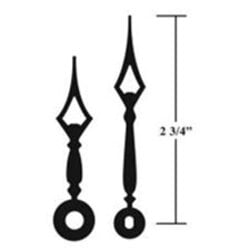Clock Hands

Concentrate On Clock Hands for Appealing Timepieces

Are clock hands meaningful, either for the clockmaker or for the observer of his or her work? Do the clock hands have strictly a functional duty-- just marking time-- or might they contribute an affect or a hint of design? The purpose of this write-up is to check out these inquiries and find exactly how subtleties of basic timepiece components can occasionally rise to the degree of art.
Clock hands are actually the main focal point when viewers effortlessly glance over to acquire the time. The eyes register their positioning or positioning and then realize the digits or signs referencing hours and minutes. However, unless overdone to distraction, decorating the components stylistically can not hurt and probably may add a touch of motivation or pleasure.
In addition, going to the effort of diversifying component styles does not cost one anything. On-line part suppliers usually charge the exact same rate for a part no matter design. Nevertheless, there is potentially a multifaceted gain to be had, such as blending the clock design into space design, or setting up the components right into a linked, harmonious whole.
We recommend visiting clock components supply websites and browsing through their offerings. Anticipate to discover a large option of different parts, with each part having a range of sizes and styles. Try to find features you didn't know existed, whether cosmetic or functional, that may be just the ticket for your following watch.
Despite the fact that this short article is focused on clock hands, we want to mention that familiarizing oneself with dials offered by the exact same vendor is well worth the while in that hands and dial must be picked together. This is due to the fact that these parts are the most noticeable ones in the wrist watch, visitors treat them as a whole or device, and they ought to match each other harmoniously. Falling short to take this action might cause an unintended clash or inadequate contrast in between hands and dial background.
Do not mark down strong comparison, for it contributes both to appearance and functionality. Excellent contrast tends to minimize eyestrain, since it helps with realizing the time swiftly without unduly tiring the eyes. If you include a pre-owned, we recommend that it contrast with both the dial and the other hands, not just in terms of saturation but likewise of shade.
One method the clock hands can contribute to timepiece good looks is with time extensions that move the factor of reset past the average 12 hours to 1 day, 1 week, or 1 month. An added hand is required to offer the extra distinction, such as indicating the day of the week or the present date, and a specifically adjusted dial has to be used that shows that details and so that the movement knows exactly how to orient the hand accordingly. If you build a watch with time expansions, make sure to have all the components contrast well with one another.
Another enchanting option is to get a movement that tracks tide level (for shoreline citizens). Here, the duration utilized represents the lunar cycle of 24-hour and 50 mins, and a single hand suggests existing degree between low and high. An item could be created showing tide just, or incorporating tide level with ordinary timekeeping.
You can also escape periodicity by portraying specific climate sensations, such as moisture, temperature level, and barometric pressure, with the "dial" containing a scale of appropriate range and a single hand aiming at the current value within that range. The actual measures have to be sensed from the setting and transformed to the matching hand setting.
Clockmaking offers a number of methods for building informative and intriguing tools. In this short article we chose to focus on clock hands for eye-catching wrist watches.